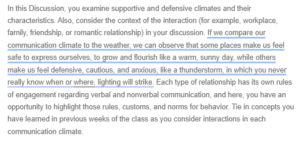How Communication Climates Shape Interactions- Exploring Supportive and Defensive Environments
During the COVID-19 pandemic, one of my friends lost her job, leading to changes in her marriage. Her husband began abusing her both emotionally and physically because she could no longer give him the money he regularly demanded. The husband also used intimidation to force her to do things she was not comfortable doing because he knew that she had no choice at the time. The emotions in the relationship included anger, frustration, and anxiety. The dark side elements of the relationship included the elements of a dysfunctional relationship discussed by Headspace (2023). The main dark side elements in a dysfunctional relationship include stonewalling, defensiveness, contempt, and criticism (Headspace, 2023). My friend also began experiencing guilt-tripping, name-calling, and intrusion before she finally decided to relocate to my place.
The elements identified in my friend’s abusive marriage gave me a new perception of people’s control over their “self.” I realized that a person can lose control of the “self” when they are continuously exposed to dark side elements that limit their self-esteem. For example, I watched how my friend lost her “self” the more she continued experiencing criticism, guilt-tripping, and emotional and physical abuse because she lost her self-esteem and self-confidence and was always in a bad mood. Hire our assignment writing services in case your assignment is devastating you.
One of the effects of the dark side elements on the relationship between my friend and her husband was a lack of communication. My friend was always afraid of approaching her husband to talk to him about something because of the uncertainty about his reaction and the assumption that she would get physically abused if she said something he did not like or agree with. The second effect was a high power imbalance in the relationship. The dark side elements in my friend’s abusive marriage gave my friend’s husband more control over her, leading to a power imbalance, which eventually led to a lack of communication.
Looking back, I might have persuaded my friend to report her husband to the relevant authorities to protect her from physical and emotional abuse before accepting her request to relocate to my place. I could also have advised my friend to consider counseling even after relocating to my place to help her regain her self-esteem and self-confidence.
References
Headspace. (2023, October 23). When do our family interactions become toxic? https://www.headspace.com/articles/toxic-family-interactions
ORDER A PLAGIARISM-FREE PAPER HERE
We’ll write everything from scratch
Question
In this Discussion, you examine supportive and defensive climates and their characteristics. Also, consider the context of the interaction (for example, workplace, family, friendship, or romantic relationship) in your discussion. If we compare our communication climate to the weather, we can observe that some places make us feel safe to express ourselves, to grow and flourish like a warm, sunny day, while others make us feel defensive, cautious, and anxious, like a thunderstorm, in which you never really know when or where, lighting will strike. Each type of relationship has its own rules of engagement regarding verbal and nonverbal communication, and here, you have an opportunity to highlight those rules, customs, and norms for behavior. Tie in concepts you have learned in previous weeks of the class as you consider interactions in each communication climate.

How Communication Climates Shape Interactions- Exploring Supportive and Defensive Environments
TO PREPARE
Read the Communication Program Discussion Guidelines.
Read “Chapter 7: Communication in Relationships” in this week’s Learning Resources.
Read “How to Know If You’re in a Toxic Friendship (and How to Get Out of It)” in this week’s Learning Resources.
Read “When Do our Family Interactions Become Toxic?” in this week’s Learning Resources.
Choose a relationship or experience that has contained at least one of the elements of the dark side of interpersonal communication (jealousy, rumor, envy, bullying, aggression, etc.) or how seemingly productive communication becomes dysfunctional (and vice versa). This could be a professional relationship, a family relationship, a friendship or a romantic relationship.
Post a response that addresses the following:
Describe the relationship, the emotions, and the dark side element(s) that you identified.
How did these elements affect your concept of self?
Evaluate the effects of the dark side elements on the relationship.
Looking back, what might you have done differently in that situation?

